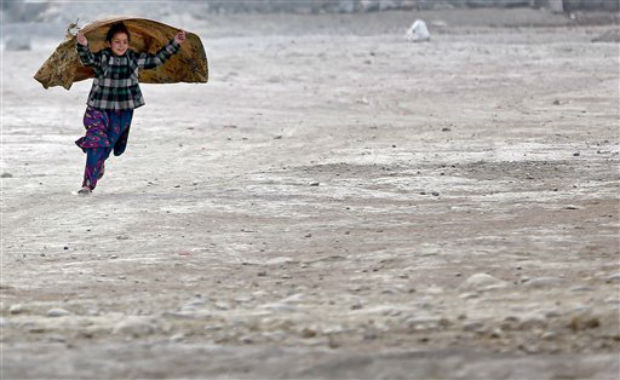Afgans fleeing war now face brutal winter

In this Wednesday, Dec. 24, 2014 photo, an internally displaced Afghan girl runs at a camp in Kabul, Afghanistan. AP
ABUL, Afghanistan—Thousands of Afghans are pouring into makeshift camps in the capital where they face a harsh winter as the Taliban return to areas once cleared by foreign forces, who this week are marking the end of their combat mission.
On the grimy outskirts of Kabul, hundreds of families are huddled in flimsy tents or mud shelters at the Bagrami camp. By day the children forage for fuel and food. At night the families burn garbage to try to keep warm as the icy winds sweep down from the Hindu Kush mountains surrounding the city and temperatures plunge to below freezing.
“Violence has forced us out of our homes but here misery and poverty have made our life even more difficult,” said Abdul Qayyum, 52, who fled here with his wife and eight children. “Such a life is not worth living.”
Like the others in the camp, they fled their home in Sangin in the volatile Helmand province, an opium-rich region where the British struggled for years to keep the Taliban at bay before withdrawing in 2010.
The insurgents are now once again on the move, and have extended the summer fighting season as foreign forces have handed over front-line combat responsibility to Afghan security forces. This week the United States and the North Atlantic Treaty Organization (NATO) are formally ending their combat mission, 13 years after the invasion that toppled the Taliban in the wake of the Sept. 11 attacks.
The insurgents have taken advantage of the vacuum and seized territory across the country, redrawing battle lines through urban areas and putting civilians at greater risk. The Sangin fighting began in June after Afghan forces replaced withdrawing U.S. troops.
Emanuele Nannini, project coordinator of the Emergency aid organization, says its 90-bed hospital in Helmand’s capital Lashkar Gah has been full for months with wounded civilians and combatants from both sides of the Sangin fighting. Unlike previous years, he said there had been no winter slowdown. The facility is “100 percent a war hospital,” he added.
This has been the bloodiest year of the war for civilians, with the toll of dead and wounded expected to hit 10,000 for the first time since the U.N. began keeping records in 2008.
Sangin is not the only place in Helmand where the Taliban are attempting to reclaim territory, said Omar Zwak, spokesman for the provincial governor. But it is an important junction on the insurgents’ supply routes and their access line to the capital. Zwak estimates that 3,000 families have been displaced from northern Helmand, mostly Sangin, since the summer.
Some of that tragic fallout from the renewed violence can be found in Bagrami, in Kabul’s eastern suburbs. People have been coming here from Sangin for the past six months, but conditions are so poor that many long for the war zones they left.
The Bagrami camp is effectively an illegal settlement on public parkland in a middle-class Kabul suburb. There is little local sympathy for the displaced, many in the camp said. Local authorities have objected to proposals to dig a well to provide more water for the 400 families here, and residents complain about the smoke from the fires as the displaced burn whatever they can find for heating and cooking.
After a mild start, the worst of the winter is yet to come. Temperatures can fall to well below freezing, with searing winds off the mountains and snow that turns to filthy ice. Every year scores of people—mainly children and the elderly—die of cold and hunger, though no precise figures exist.
Bebi has been at the camp for six months, she said, after losing her husband and oldest son when they were caught in the crossfire of a gunfight between government forces and insurgents. The men had stopped their farm work for a tea break when the firing started. “They were killed before my eyes,” she said.
She rounded up her remaining five children and made the 630-kilometer (390-mile) journey to Kabul in the hope of finding some means of support now that the breadwinners of her family are dead.
“I am so worried about my children,” said Bebi, who like many Afghans goes by one name. “We have no food, no water and even no blankets to keep my children warm.”
The cash-strapped United Nations Office for the Coordination of Humanitarian Affairs plans to distribute some relief—food, children’s clothing, firewood and plastic sheeting for shelter. But the agency’s deputy head in Afghanistan, Catherine Howard, told people in the camp during a recent visit that there was no money for blankets.
“It is really a struggle to get the money needed,” she said.
RELATED STORIES
US, NATO end 13-year war in Afghanistan